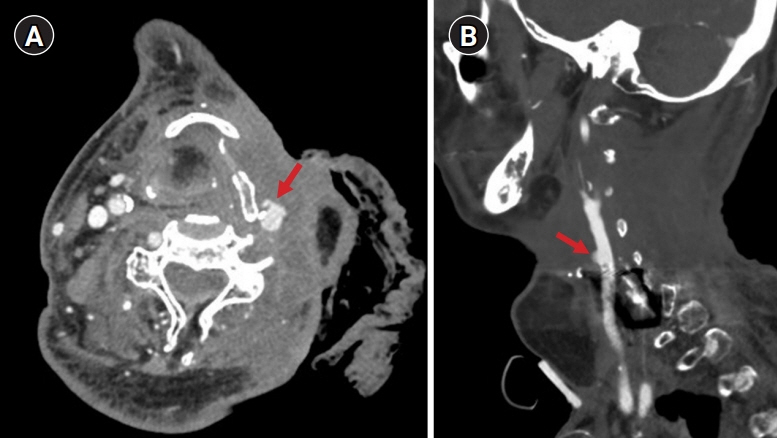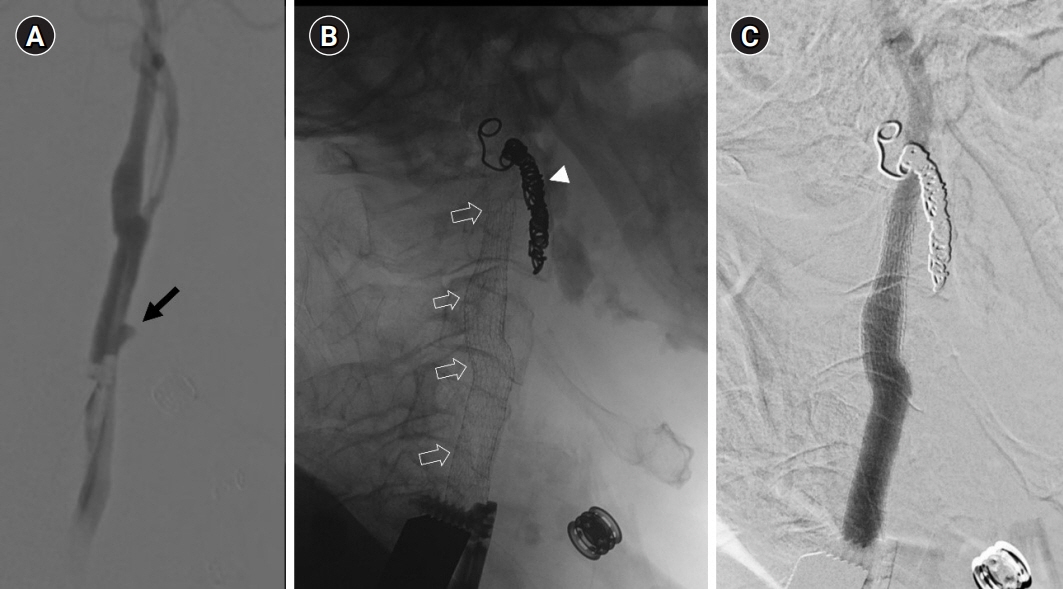J Neurocrit Care.
2022 Dec;15(2):141-145. 10.18700/jnc.220059.
Cerebral hyperperfusion syndrome after endovascular stent graft reconstruction for postirradiated carotid blowout syndrome: a case report
- Affiliations
-
- 1Department of Medical Imaging, National Taiwan University Hospital, Taipei City, Taiwan
- KMID: 2538773
- DOI: http://doi.org/10.18700/jnc.220059
Abstract
- Background
Cerebral hyperperfusion syndrome (CHS) is a failure of autoregulation after a revascularization procedure. It has rarely been reported in patients with no pre-existing cerebral hypoperfusion.
Case Report
We present a rare case of a patient who underwent stent graft implantation to treat postirradiated carotid blowout syndrome. The patient developed hypertension, focal neurological deficit, and seizures after the procedure; neuroimages revealed ipsilateral cerebral edema, swelling, and increased cerebral perfusion. CHS was diagnosed based on clinical and radiological findings. The patient recovered gradually after receiving supportive care.
Conclusion
Owing to the risk of CHS, monitoring for cerebral perfusion and prevention of hypertension is suggested for patients who undergo stent graft placement for postirradiated carotid blowout syndrome.
Figure
Reference
-
1. Lin YH, Liu HM. Update on cerebral hyperperfusion syndrome. J Neurointerv Surg. 2020; 12:788–93.
Article2. Suárez C, Fernández-Alvarez V, Hamoir M, Mendenhall WM, Strojan P, Quer M, et al. Carotid blowout syndrome: modern trends in management. Cancer Manag Res. 2018; 10:5617–28.
Article3. Bond KM, Brinjikji W, Murad MH, Cloft HJ, Lanzino G. Endovascular treatment of carotid blowout syndrome. J Vasc Surg. 2017; 65:883–8.
Article4. Chang FC, Luo CB, Lirng JF, Lin CJ, Lee HJ, Wu CC, et al. Endovascular management of post-irradiated carotid blowout syndrome. PLoS One. 2015; 10:e0139821.
Article5. Shimamura N, Naraoka M, Matsuda N, Katayama K, Kakuta K, Katagai T, et al. Intra-arterial oxidative stress correlates negatively with cognitive function and positively with postoperative ischemic lesions in carotid artery stenosis stenting. J Neurointerv Surg. 2018; 10:440–5.
Article6. Nouraei SA, Al-Rawi PG, Sigaudo-Roussel D, Giussani DA, Gaunt ME. Carotid endarterectomy impairs blood pressure homeostasis by reducing the physiologic baroreflex reserve. J Vasc Surg. 2005; 41:631–7.
Article7. Macfarlane R, Moskowitz MA, Sakas DE, Tasdemiroglu E, Wei EP, Kontos HA. The role of neuroeffector mechanisms in cerebral hyperperfusion syndromes. J Neurosurg. 1991; 75:845–55.8. Sharabi Y, Dendi R, Holmes C, Goldstein DS. Baroreflex failure as a late sequela of neck irradiation. Hypertension. 2003; 42:110–6.9. Ecker RD, Murray RD, Seder DB. Hyperperfusion syndrome after stent/coiling of a ruptured carotid bifurcation aneurysm. Neurocrit Care. 2013; 18:54–8.
Article10. Hirai S, Saigusa K, Norisue Y, Nemoto S. Cerebral hyperperfusion syndrome after endovascular covered stent grafting for a giant extracranial aneurysm of the internal carotid artery. J Vasc Surg Cases. 2015; 1:46–9.
Article
- Full Text Links
- Actions
-
Cited
- CITED
-
- Close
- Share
- Similar articles
-
- Hyperacute hyperperfusion intracerebral hemorrhage complicating carotid endarterectomy: A case report
- Hyperperfusion Syndrome after Carotid Stent-Supported Angioplasty in Patients with Autonomic Dysfunction
- Stent-Graft Repair of Common Carotid Pseudoaneurysms in Behcet's Syndrome
- Fatal Propofol Infusion Syndrome Associated with Refractory Partial Status Epilepticus in a Patient with Cerebral Hyperperfusion Syndrome
- Delayed Cerebral Hyperperfusion Syndrome Three Weeks after Carotid Artery Stenting Presenting as Status Epilepticus




